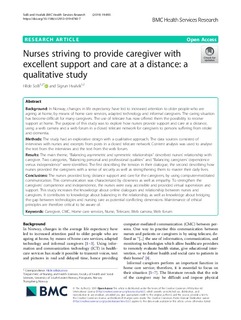| dc.contributor.author | Solli, Hilde | |
| dc.contributor.author | Hvalvik, Sigrun | |
| dc.date.accessioned | 2019-12-04T07:54:10Z | |
| dc.date.available | 2019-12-04T07:54:10Z | |
| dc.date.created | 2019-12-03T12:02:49Z | |
| dc.date.issued | 2019 | |
| dc.identifier.citation | BMC Health Services Research. 2019, 19 (1), 893-?. | nb_NO |
| dc.identifier.issn | 1472-6963 | |
| dc.identifier.uri | http://hdl.handle.net/11250/2631647 | |
| dc.description | This article is distributed under the terms of the Creative Commons Attribution 4.0 International License which permits unrestricted use, distribution, and reproduction in any medium, provided you give appropriate credit to the original author(s) and the source, provide a link to the Creative Commons license, and indicate if changes were made. | nb_NO |
| dc.description.abstract | Background
In Norway, changes in life expectancy have led to increased attention to older people who are ageing at home, by means of home care services, adapted technology and informal caregivers. The caring situation has become difficult for many caregivers. The use of telecare has now offered them the possibility to receive support at home. The purpose of this study was to explore how nurses provide support and care at a distance, using a web camera and a web forum in a closed telecare network for caregivers to persons suffering from stroke and dementia.
Methods
The study had an explorative design with a qualitative approach. The data sources consisted of interviews with nurses and excerpts from posts in a closed telecare network. Content analysis was used to analyse the text from the interviews and the text from the web forum.
Results
The main theme, “Balancing asymmetric and symmetric relationships” described nurses’ relationship with caregiver. Two categories, “Balancing personal and professional qualities” and “Balancing caregivers’ dependence versus independence” were identified. The first describing the tension in their dialogue, the second describing how nurses provided the caregivers with a sense of security as well as strengthening them to master their daily lives.
Conclusions
The nurses provided long distance support and care for the caregivers, by using computer-meditated communication. This communication was characterized by closeness as well as empathy. To strengthen the caregivers’ competence and independence, the nurses were easy accessible and provided virtual supervision and support. This study increases the knowledge about online dialogues and relationship between nurses and caregivers. It contributes to knowledge about balancing in the relationship, as well as knowledge about bridging the gap between technologies and nursing care as potential conflicting dimensions. Maintenance of ethical principles are therefore critical to be aware of. | nb_NO |
| dc.language.iso | eng | nb_NO |
| dc.rights | Navngivelse 4.0 Internasjonal | * |
| dc.rights.uri | http://creativecommons.org/licenses/by/4.0/deed.no | * |
| dc.title | Nurses striving to provide caregiver with excellent support and care at a distance: a qualitative study | nb_NO |
| dc.type | Journal article | nb_NO |
| dc.type | Peer reviewed | nb_NO |
| dc.description.version | publishedVersion | nb_NO |
| dc.rights.holder | © The Author(s). 2019 | nb_NO |
| dc.source.pagenumber | 893-? | nb_NO |
| dc.source.volume | 19 | nb_NO |
| dc.source.journal | BMC Health Services Research | nb_NO |
| dc.source.issue | 1 | nb_NO |
| dc.identifier.doi | 10.1186/s12913-019-4740-7 | |
| dc.identifier.cristin | 1755983 | |
| cristin.unitcode | 222,56,1,0 | |
| cristin.unitname | Institutt for sykepleie- og helsevitenskap | |
| cristin.ispublished | true | |
| cristin.fulltext | original | |
| cristin.qualitycode | 2 | |

